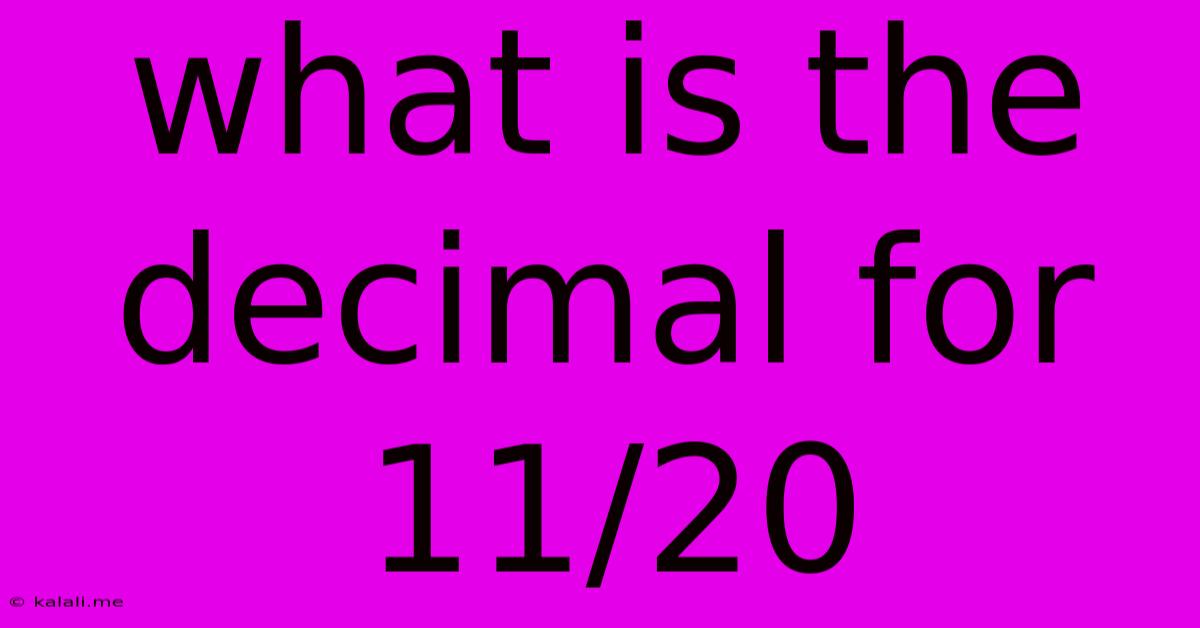What Is The Decimal For 11/20
Kalali
May 09, 2025 · 2 min read

Table of Contents
What is the Decimal for 11/20? A Simple Guide to Fraction Conversion
What is the decimal equivalent of 11/20? This is a common question in math, especially when working with percentages, measurements, or data analysis. Understanding how to convert fractions to decimals is a fundamental skill. This guide will walk you through the process of converting the fraction 11/20 into its decimal form, and explain the underlying principles involved. We'll also look at some related conversions and explore practical applications.
The simplest method for converting a fraction like 11/20 to a decimal involves performing division. The fraction represents a division problem: the numerator (11) is divided by the denominator (20).
The Calculation:
To find the decimal equivalent of 11/20, simply divide 11 by 20:
11 ÷ 20 = 0.55
Therefore, the decimal equivalent of the fraction 11/20 is 0.55.
Understanding the Process:
The process of converting a fraction to a decimal essentially involves expressing the fraction as a part of a whole, represented as a number less than one. The denominator indicates how many equal parts the whole is divided into, while the numerator represents how many of those parts are being considered. Dividing the numerator by the denominator provides the decimal representation, which shows the fractional part as a portion of one.
Alternative Methods (for more complex fractions):
While this method is straightforward for simpler fractions, some fractions might require different approaches. For example, if the denominator isn't easily divisible, you might need to simplify the fraction first or use long division. Converting fractions with larger numbers might also benefit from the use of a calculator.
Practical Applications:
Understanding fraction-to-decimal conversion has numerous applications in various fields:
- Finance: Calculating percentages, interest rates, and proportions.
- Measurement: Converting units of measurement (e.g., inches to centimeters).
- Data Analysis: Representing statistical data and creating charts and graphs.
- Engineering: Working with precise calculations and measurements.
Related Conversions:
It's also helpful to understand related conversions, such as converting decimals to percentages and vice versa. For example, 0.55 is equivalent to 55%. Understanding these interrelationships strengthens your mathematical foundation.
In Conclusion:
Converting fractions to decimals is a crucial skill. The method outlined above provides a clear and concise way to convert 11/20 into its decimal equivalent, 0.55. Mastering this process allows you to handle a wide range of numerical calculations efficiently and confidently in various practical scenarios. Remember that understanding the underlying concepts enhances problem-solving abilities and broadens mathematical literacy.
Latest Posts
Latest Posts
-
Cuanto Es 5 Pulgadas En Metros
May 09, 2025
-
How Many Grams Is 5 3 Ounces
May 09, 2025
-
Cuanto Equivale Un Pie En Centimetros
May 09, 2025
-
Has A Definite Volume And Shape
May 09, 2025
-
Is 38 A Prime Number Or A Composite Number
May 09, 2025
Related Post
Thank you for visiting our website which covers about What Is The Decimal For 11/20 . We hope the information provided has been useful to you. Feel free to contact us if you have any questions or need further assistance. See you next time and don't miss to bookmark.